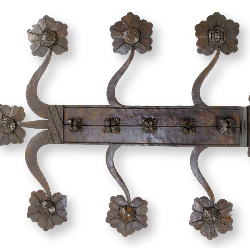
An important consideration when planning a project is what material is best suited for the job. Today we can forge in a variety of metals and achieve beautiful results. Robert Frieber, Artist In Iron works primarily in iron and bronze. Both of these metals produce beautiful end results when forged, however depending on the application, both metals offer their own advantages and disadvantages which should be considered when choosing the metal to use.
Blacksmithing technically refers to the forging of iron and its alloys. Prior to the industrial revolution, iron material was largely limited to wrought iron. Wrought means: to hammer. Wrought iron is iron that is made by hammering the iron bloom that is produced in the smelting of ore. Hammering the bloom removes the impurities such as slag, silica and carbon. When the wrought process is finished, the resulting product is relatively pure iron.
Pure iron rusts very slowly and can be exposed to the elements with little concern for oxidation. The more carbon in the iron, the more it is prone to rust. Therefore, a high grade of pure wrought iron was preferred by a blacksmith who forged things that would be exposed to the weather.
Since the start of the Industrial revolution, wrought iron has steadily given way to steel. the last supporting market for wrought iron was for marine application. In 1964, the commercial production of wrought iron ceased.
Today, all blacksmiths use mild steel for forging decorative iron work. Mild steel has a low carbon content and some other elements that give it greater strength than wrought iron, but it will not hold up well to the weather without protective measures such as painting or galvanisation. These rust preventative measures tend to hide the desirable character of hammer marks, pitting and burn texture which are the classic fingerprint of wrought iron work. To the discerning eye, this loss of character is noticeable and undesirable. Maintenance is also a concern. Paint needs to be reapplied every 5 to ten years. Galvanisation may last longer by the process requires dipping the work in hot liquified metal baths which can stress the metal and cause it to warp. The galvanised finish is also thick and often lumpy which detracts from the aesthetic appearance of the hand hammered texture that is so sought after in true wrought iron artwork.
A good alternative to iron on metal work that will be exposed to the weather is silicon bronze. Silicon bronze will not rust and develops a fine textured finish comparable to iron when forged. When exposed to the elements, the bronze forms a light oxide coating which gives it a beautiful coffee brown patina, sometimes with highlights of green, grey and red, depending on the elements it is being exposed to. Bronze needs no protective coating to survive elements and is therefore maintenance free.
The downside to using bronze is that it is 30% heavier than iron and costs about 10 times as much pound for pound. Keep in mind however, that the cost of labor in most hand forged metal work far exceeds the cost of materials. When you factor in the savings of bronze being maintenance free, it is the material of choice for exterior wrought metal work. A consideration when using bronze is that it is not as strong as iron. If the end product will be supporting weight such as hinges supporting a gate or heavy door, it is advisable to increase the thickness of the metal or beef up the structural design of the work as needed.
One final point worth mentioning is that the surface texture of iron and bronze have subtle differences when being forged. Iron burns in the forge and will produce more scale than bronze. As such, the surface will show more pitting and topography than bronze in the finished product. This is particularly evident in forgings that are viewed close up such as hardware and should be taken into consideration especially for interior projects where this difference becomes more apparent.
If you have any questions or need advise on a project, don’t hesitate to call or email us via our contact page.